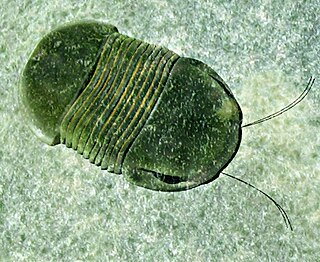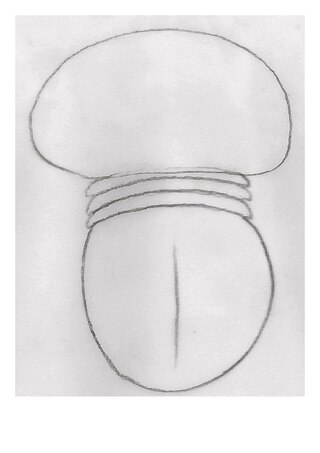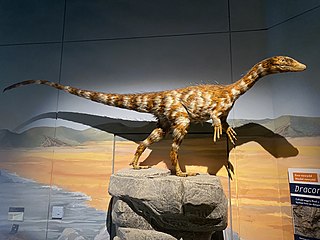
Trilobites are extinct marine arthropods that form the class Trilobita. Trilobites form one of the earliest known groups of arthropods. The first appearance of trilobites in the fossil record defines the base of the Atdabanian stage of the Early Cambrian period and they flourished throughout the lower Paleozoic before slipping into a long decline, when, during the Devonian, all trilobite orders except the Proetida died out. The last trilobites disappeared in the mass extinction at the end of the Permian about 251.9 million years ago. Trilobites were among the most successful of all early animals, existing in oceans for almost 270 million years, with over 22,000 species having been described.

Anomalocaris is an extinct genus of radiodont, an order of early-diverging stem-group arthropods.

Gravicalymene Shirley, 1936, is a genus of trilobites belonging to the order Phacopida, suborder Calymenina and family Calymenidae. Species included in this genus have previously been allocated to Calymene Brongniart 1822,Flexicalymene Shirley, 1936. and Sthenarocalymene Siveter 1977.

Naraoia is a genus of small to average size marine arthropods within the family Naraoiidae, that lived from the early Cambrian to the late Silurian period. The species are characterized by a large alimentary system and sideways oriented antennas.

Yunnanocephalus is a genus of ptychopariid trilobite. It lived during the late Atdabanian and Botomian stages, in what are currently Antarctica, Australia and China. It was a "moderately common" member of the Chengjiang Fauna. Yunnanocephalus is the only genus currently assigned to the Yunnanocephalidae family.

Sinodiscus is an extinct genus from a well-known class of fossil marine arthropods, the trilobites. It lived during the late Atdabanian stage, which lasted from 530 to 524 million years ago during the early part of the Cambrian Period.

Pagetia is a genus of small trilobite, assigned to the Eodiscinid family Pagetiidae and which had global distribution during the Middle Cambrian. The genus contains 55 currently recognized species, each with limited spatial and temporal ranges.

Phytophilaspis is a phosphatized genus of trilobite-like arthropod with eyes, found in association with algal remains. It dwelt in well-lit, shallow waters.

Bumastus is an extinct genus of corynexochid trilobites which existed from the Early Ordovician period to the Late Silurian period. They were relatively large trilobites, reaching a length of 6 in (15 cm). They were distinctive for their highly globular, smooth-surfaced exoskeleton. They possessed well-developed, large compound eyes and were believed to have dwelled in shallow-water sediments in life.

Soomaspis is a genus of small to average size marine arthropods in the Liwiidae Family, that lived during the late Ordovician. Fossil remains of Soomaspis were collected from the Soom Shale Lagerstätte in Western Cape, South Africa. Soomaspis looks like a large, soft agnostid trilobite. It has a headshield wider than the tailshield (pygidium), and in between them three thoracic body segments (somites). The genus is monotypic, its sole species being Soomaspis splendida.

Proetus is a genus of proetid trilobite found in Silurian-aged marine strata of Europe.
The Gnishik Formation is a geologic formation in Armenia, Azerbaijan and Iran. It preserves fossils dated to the Wordian age of the Permian period.
The Dovžan Gorge Formation is a geologic formation in Slovenia. It preserves fossils dating back to the Permian period. The formation is named after the Dovžan Gorge.
2021 in arthropod paleontology is a list of new arthropod fossil taxa, including arachnids, crustaceans, insects, trilobites, and other arthropods that were announced or described, as well as other significant arthropod paleontological discoveries and events which occurred in 2021.
2022 in arthropod paleontology is a list of new arthropod fossil taxa, including arachnids, crustaceans, insects, trilobites, and other arthropods that were announced or described, as well as other significant arthropod paleontological discoveries and events which occurred in 2022.
Pugnoides is an extinct genus of brachiopod belonging to the order Rhynchonellida and family Petasmariidae. Specimens have been found in Devonian to Permian beds in North America, Asia, Europe, western Australia, New Zealand,and New Zealand. The genus was particularly widespread in the Visean.

Anisopyge is an extinct genus of trilobite belonging to the order Proetida and family Phillipsiidae. Specimens have been found in Permian beds in North and Central America.
Tibetima is a small genus of east Asian palp-footed spiders. It was first described by Y. J. Lin and S. Q. Li in 2020, and it has only been found in China. As of March 2022 it contains only two species: T. char and T. gyirongensis.

Palaeontology in Wales is palaeontological research occurring in Wales.
2023 in arthropod paleontology is a list of new arthropod fossil taxa, including arachnids, crustaceans, trilobites, and other arthropods that were announced or described, as well as other significant arthropod paleontological discoveries and events which occurred in 2023.












